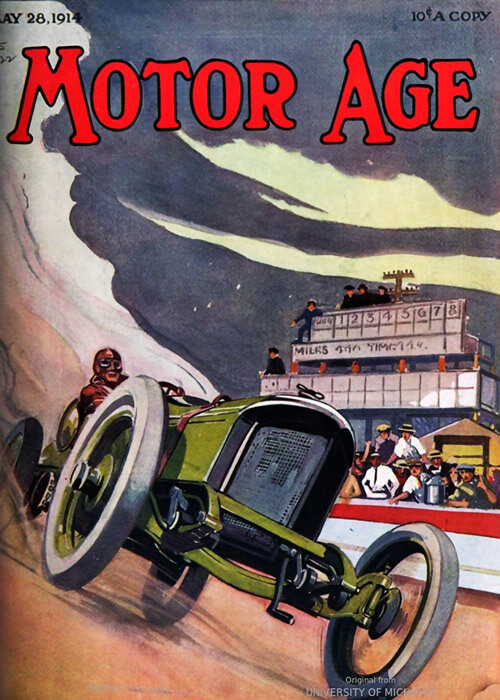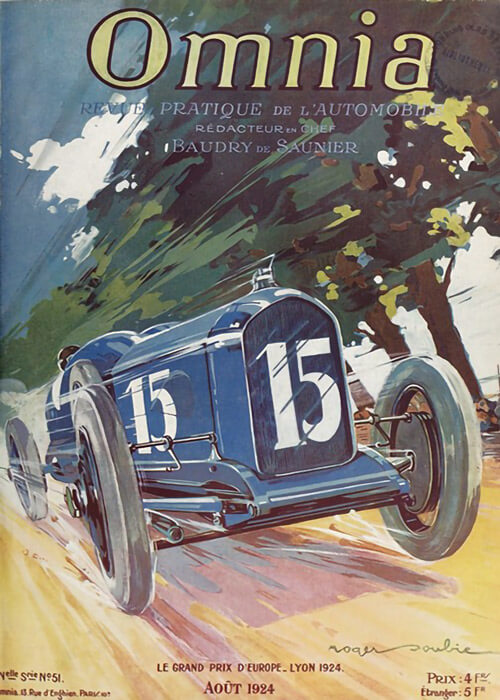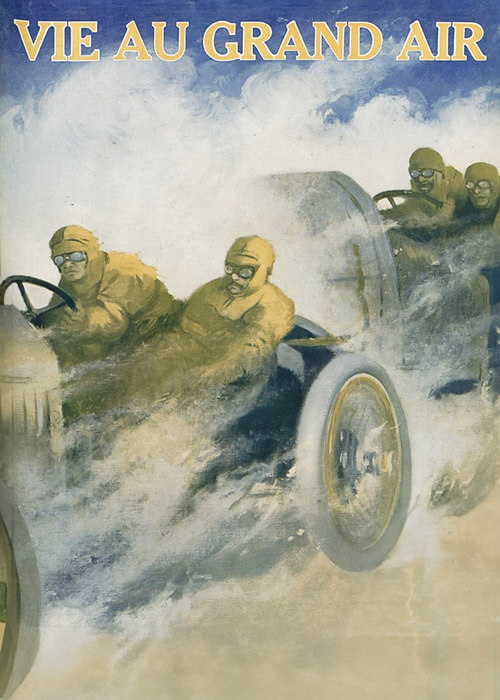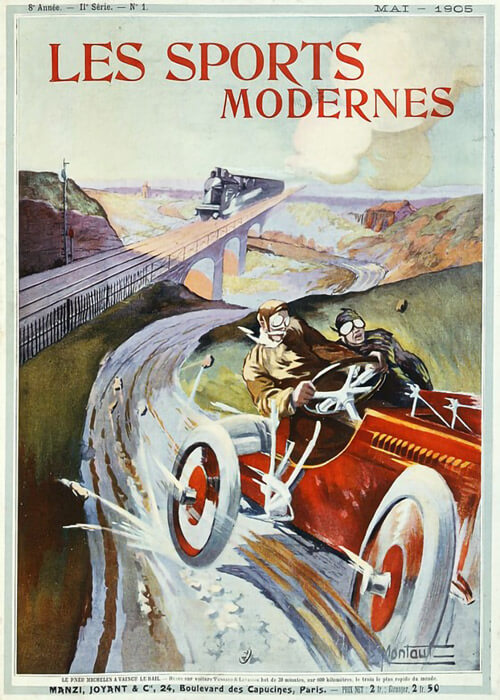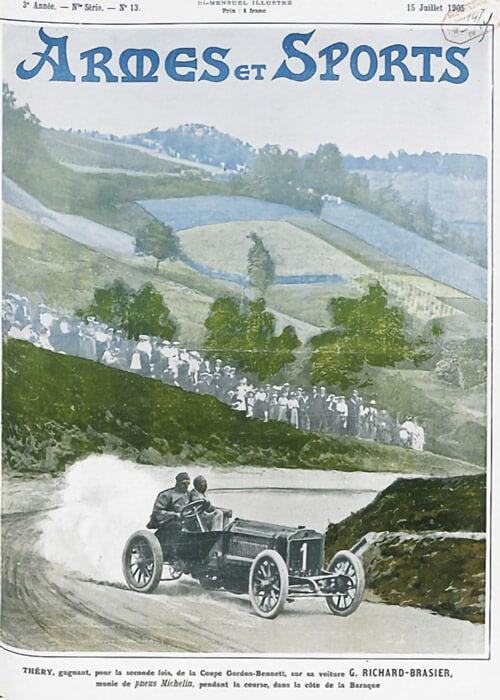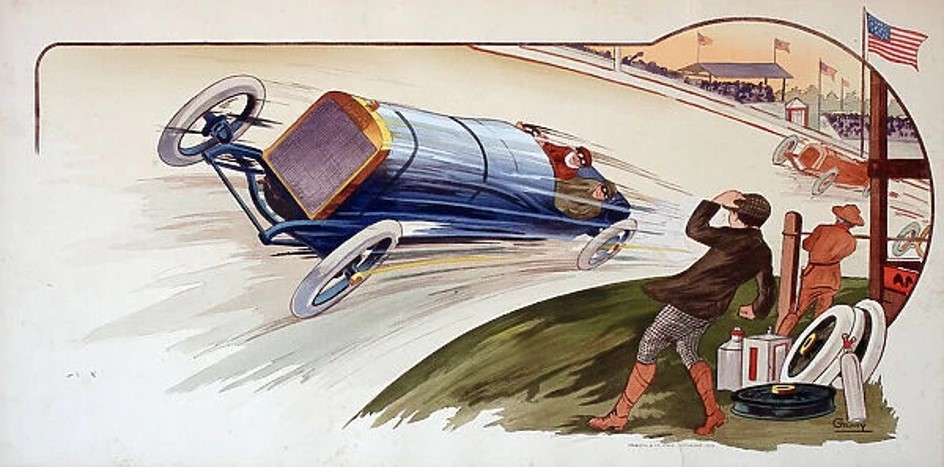The speedway neared it’s completion beginning of June 1909, when Automobile Topics wrote about the track’s typicalities. And it showed a now famous photo of Carl Fisher with some officials in his Stoddard-Dayton, driving over a banked turn of the speedway. The colourised version on „I Love To make The Dirt fly!“ already shows, that the track surface, although not finalised with the final tarry layer, already indicated the coming catasprophy of the August 1909 races.
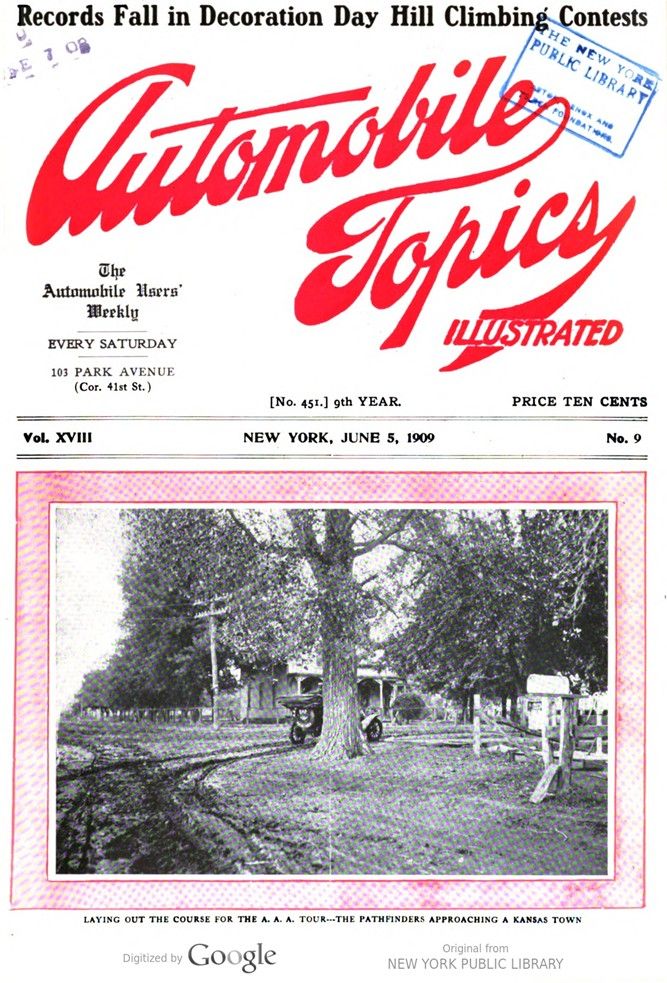
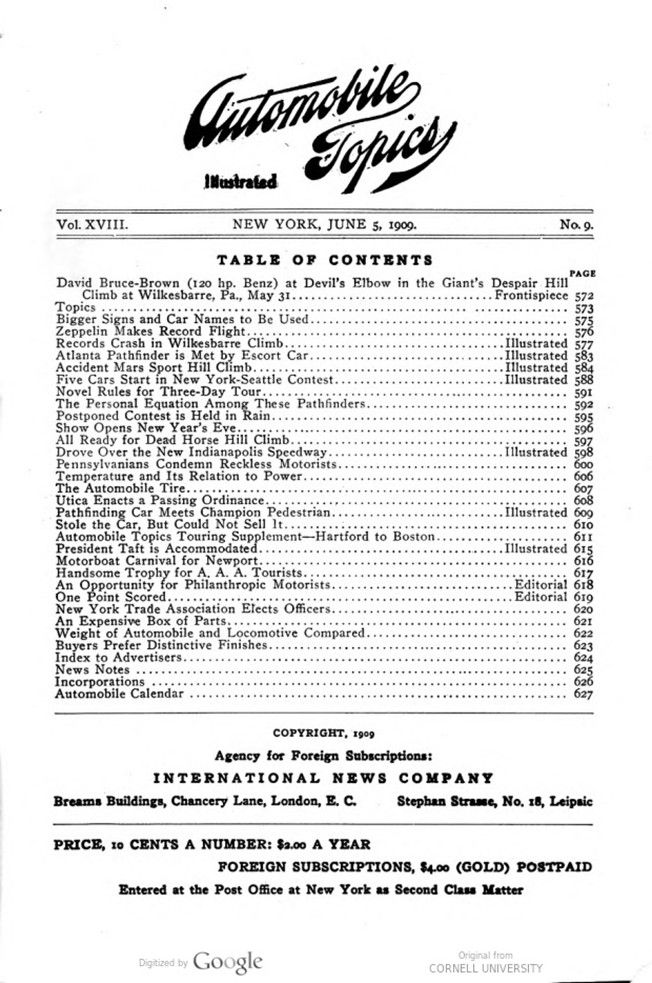
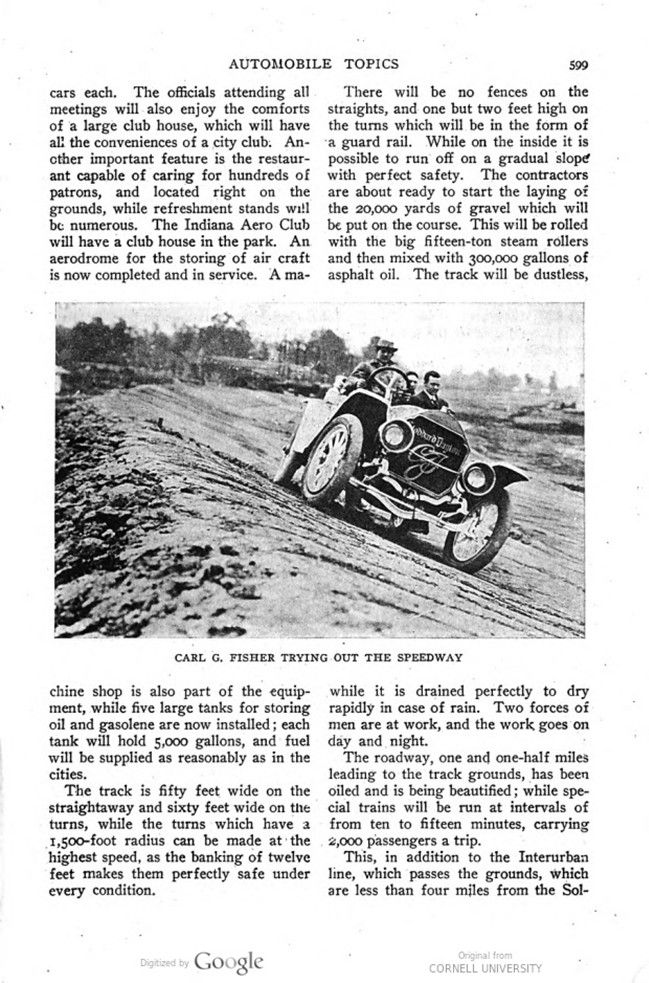
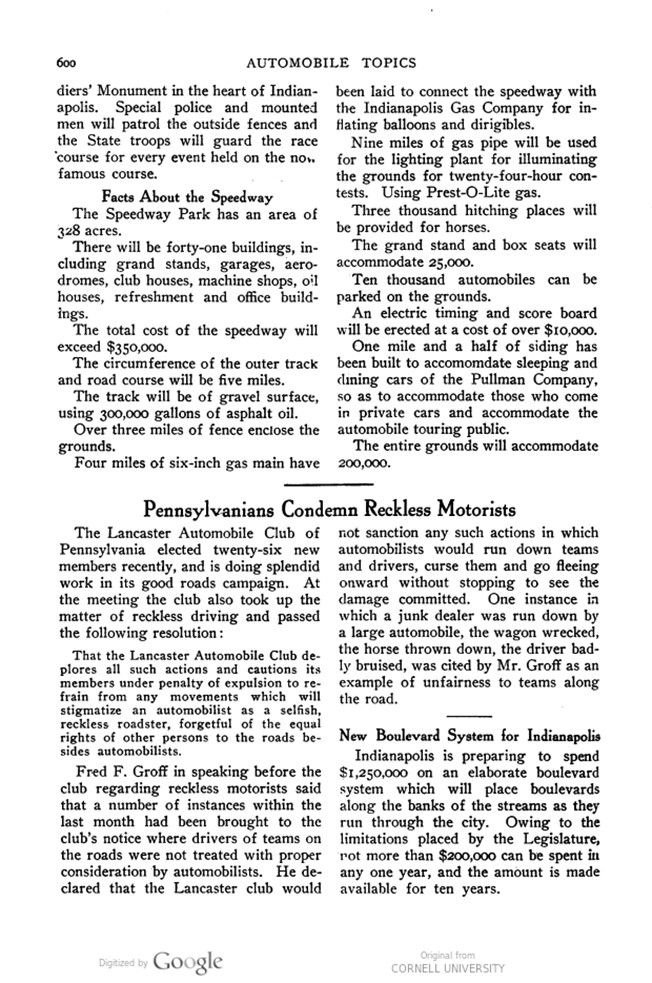
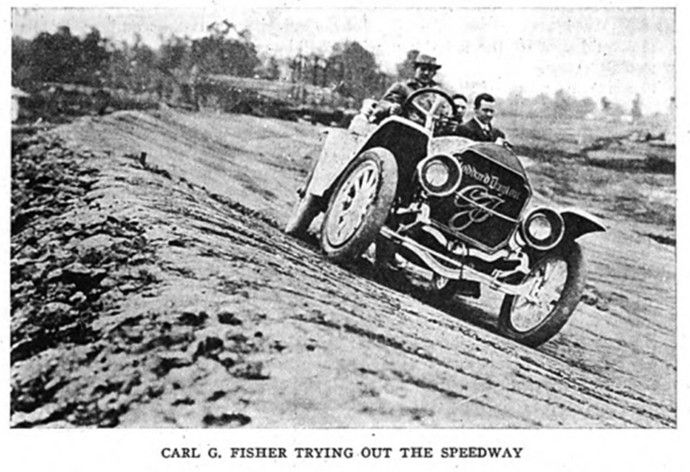

Text and jpegs by courtesy of hathitrust.org www.hathitrust.org, compiled by motorracinghistory.com
AUTOMOBILE TOPICS, Vol. XVIII, No. 9, June 5, 1909
Drove Over the New Indianapolis Speedway
What was a dream a few months ago is a realization to-day, for the Indianapolis Motor Speedway is an accomplished fact and a car has been driven. over its newly made surface. This interesting event occurred last week and was a grand stand display, so to speak, for the final surface had not been laid on the track and the banking had not been entirely completed.
The trial was made by Carl G. Fisher, president of the Speedway company, who, with a party of Indianapolis newspaper men drove around the parkway.
Long before the grounds were reached the track was visible, extending several feet higher than the fence at the upper turn, which is banked to fifteen feet in height.
Riding around the track at slow speed is only done with discomfort, as the steep grades on the huge turn, which is almost a straightaway, is built for high speed.
Rounding the turn the great gray stretch extends like a long ribbon to the upper turn, where it disappears in a smoky streak. It will be down these stretches that the great speed demons (sic) will careen as they travel at the rate of 110 miles an hour, and with the great banked turns it will be possible to round the turn when traveling at that great rate of speed.
Experts have stated that it will he possible to travel at the rate of two miles a minute over this, the greatest course ever engineered. As no expense is being spared, there is no reason why the greatest dream of its engineers should not be realized.
Several huge steam shovels are at work constructing the inner road racing course, while three big fifteen-ton and one smaller steam roller are rolling the track to a billiard table smoothness.
By the middle of June the finishing layer of crushed stone will be laid and then the track will be in readiness for the oil application.
The management is well satisfied with the progress that has been made while the recent rains have had a tendency to pack the surface. Over 800 men are camped on the speedway with living quarters, while the great stables livery almost 1,000 mules.
The opening of the speedway on June 5, with the Aero Club of America’s balloon race meet, will be a proper inaugural affair for the introducing of the public to this wonderful enterprise.
When finished the speedway will be a marvel of completeness, surpassing anything yet planned, or even projected, in this line. In addition to the great grand stands there will be twenty small stands for motoring clubs and parties. Opposite the main grand stand there is a press stand three stories high. The top floor will be for reporting the progress of the races, as the elevation furnishes a fine survey of the track and grounds.
The second story of the press stand will be for the telegraph operators, while the ground floor will be equipped as a dark room for developing the press photos taken on the track. It will be the largest press stand ever built and will accommodate seventy-five press representatives and photographers at any one time; the press stand will adjoin the judges‘ stand.
The comfort of the men who come to the track with cars for competition will receive attention.
Ten buildings will be erected for their use, each building holding a team of three cars. Sleeping rooms will be provided in each building for the individual members of each team.
There will also be two large general garages which will accommodate twelve cars each. The officials attending all meetings will also enjoy the comforts of a large club house, which will have all the conveniences of a city club. Another important feature is the restaurant capable of caring for hundreds of patrons, and located right on the grounds, while refreshment stands will be numerous. The Indiana Aero Club will have a club house in the park. An aerodrome for the storing of air craft is now completed and in service. A machine shop is also part of the equipment, while five large tanks for storing oil and gasolene are now installed; each tank will hold 5,000 gallons, and fuel will be supplied as reasonably as in the cities.
The track is fifty feet wide on the straightaway and sixty feet wide on the turns, while the turns which have a 1,500-foot radius can be made at the highest speed, as the banking of twelve feet makes them perfectly safe under every condition.
There will be no fences on the straights, and one but two feet high on the turns which will be in the form of a guard rail. While on the inside it is. possible to run off on a gradual slope with perfect safety. The contractors are about ready to start the laying of the 20,000 yards of gravel which will be put on the course. This will be rolled with the big fifteen-ton steam rollers and then mixed with 300,000 gallons of asphalt oil. The track will be dustless, while it is drained perfectly to dry rapidly in case of rain. Two forces of men are at work, and the work, goes on day and night.
The roadway, one and one-half miles leading to the track grounds, has been oiled and is being beautified; while special trains will be run at intervals of from ten to fifteen minutes, carrying 2,000 passengers a trip.
This, in addition to the Interurban line, which passes the grounds, which are less than four miles from the Soldiers‘ Monument in the heart of Indianapolis. Special police and mounted men will patrol the outside fences and the State troops will guard the race course for every event held on the now famous course.
Facts About the Speedway
The Speedway Park has an area of 328 acres.
There will be forty-one buildings, including grand stands, garages, aerodromes, club houses, machine shops, oil houses, refreshment and office buildings.
The total cost of the speedway will exceed $350,000.
The circumference of the outer track and road course will be five miles.
The track will be of gravel surface, using 300,000 gallons of asphalt oil.
Over three miles of fence enclose the grounds.
Four miles of six-inch gas main have been laid to connect the speedway with the Indianapolis Gas Company for inflating balloons and dirigibles.
Nine miles of gas pipe will be used for the lighting plant for illuminating the grounds for twenty-four-hour co tests. Using Prest-O-Lite gas.
Three thousand hitching places will be provided for horses.
The grand stand and box seats will accommodate 25,000.
Ten thousand automobiles can be parked on the grounds.
An electric timing and score board will be erected at a cost of over $10,000.
One mile and a half of siding has been built to accommodate sleeping and dining cars of the Pullman Company, so as to accommodate those who come in private cars and accommodate the automobile touring public. The entire grounds will accommodate 200,000.
